Strategic Analysis of Hilton Hotels: Market, Environment, and Planning
VerifiedAdded on 2023/01/11
|12
|3963
|25
Report
AI Summary
This report provides a comprehensive strategic analysis of Hilton Hotels, examining its business operations within the hospitality industry. It begins with an introduction to the industry and the selected organization, Hilton Hotels. The analysis then delves into the macro environment using PESTEL analysis, assessing the impact of political, economic, social, technological, legal, and environmental factors, particularly within the UK market. The internal environment and capabilities of Hilton are evaluated using SWOT and VRIO models to identify strengths, weaknesses, opportunities, and threats, as well as valuable, rare, inimitable, and organized resources. Furthermore, the report applies Porter's Five Forces model to assess the competitive forces within the hospitality sector, evaluating the threats of new entrants, substitute goods, supplier and customer bargaining power, and existing rivalry. Finally, the report concludes by interpreting and devising strategic planning for Hilton Hotels, offering insights for future business development and competitive advantage.
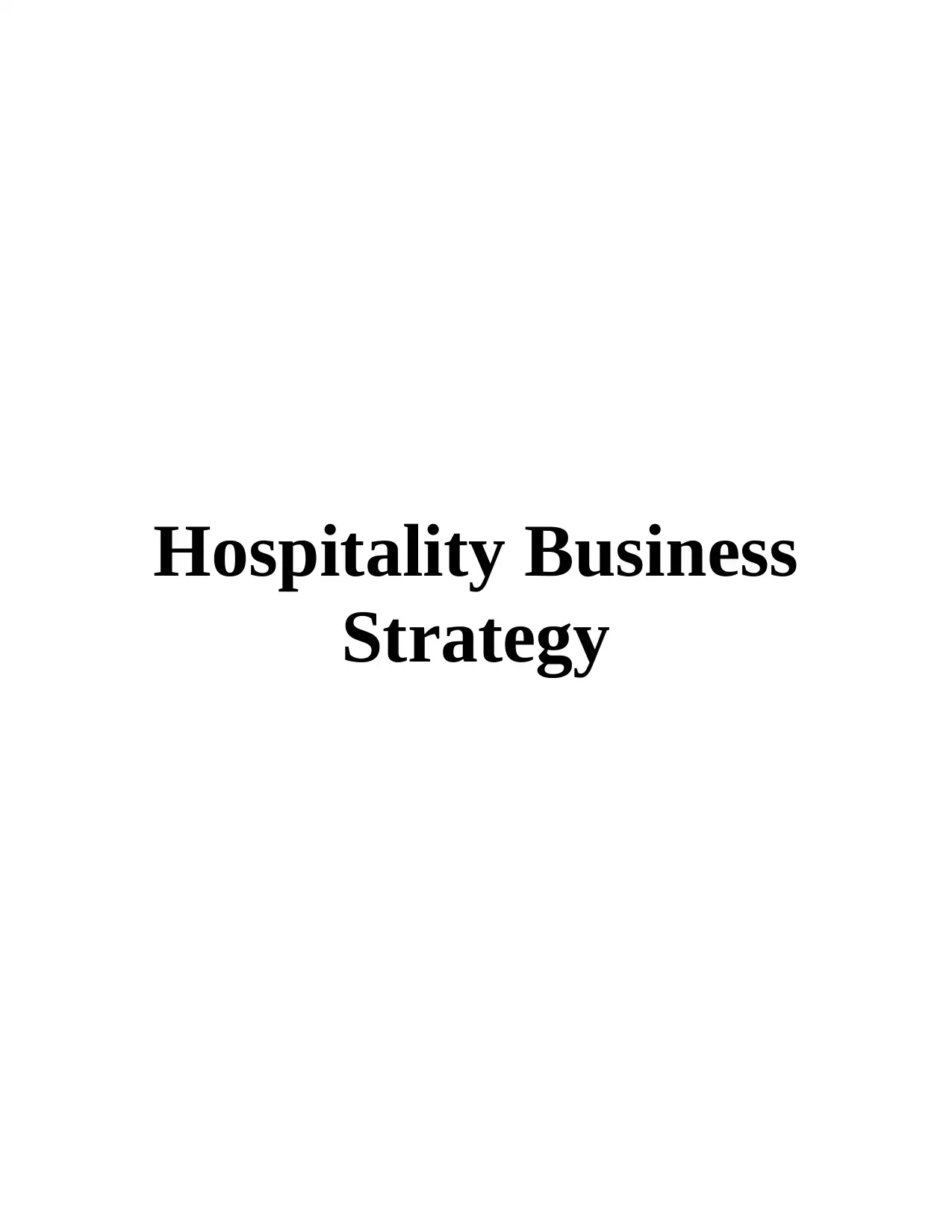
Hospitality Business
Strategy
Strategy
Paraphrase This Document
Need a fresh take? Get an instant paraphrase of this document with our AI Paraphraser
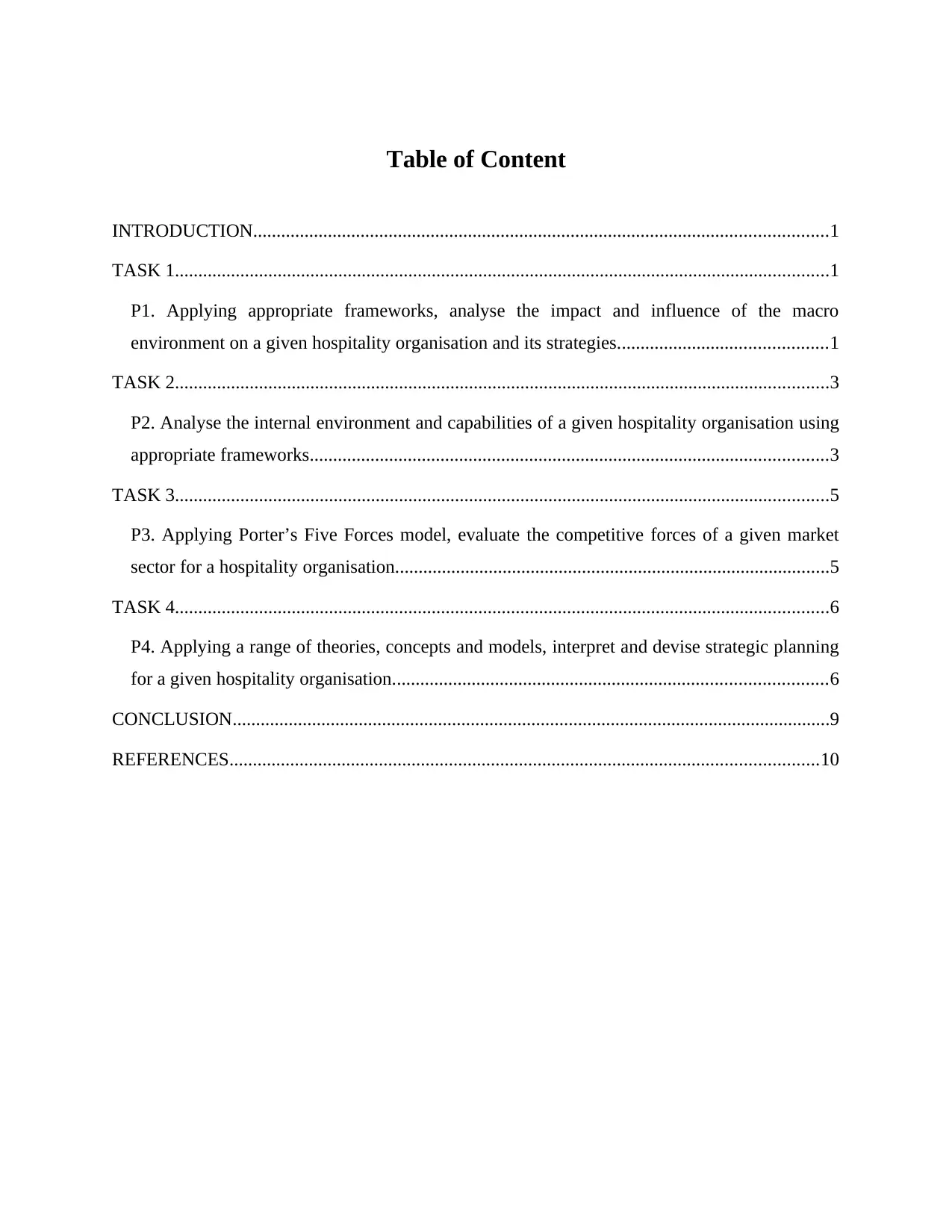
Table of Content
INTRODUCTION...........................................................................................................................1
TASK 1............................................................................................................................................1
P1. Applying appropriate frameworks, analyse the impact and influence of the macro
environment on a given hospitality organisation and its strategies.............................................1
TASK 2............................................................................................................................................3
P2. Analyse the internal environment and capabilities of a given hospitality organisation using
appropriate frameworks...............................................................................................................3
TASK 3............................................................................................................................................5
P3. Applying Porter’s Five Forces model, evaluate the competitive forces of a given market
sector for a hospitality organisation.............................................................................................5
TASK 4............................................................................................................................................6
P4. Applying a range of theories, concepts and models, interpret and devise strategic planning
for a given hospitality organisation.............................................................................................6
CONCLUSION................................................................................................................................9
REFERENCES..............................................................................................................................10
INTRODUCTION...........................................................................................................................1
TASK 1............................................................................................................................................1
P1. Applying appropriate frameworks, analyse the impact and influence of the macro
environment on a given hospitality organisation and its strategies.............................................1
TASK 2............................................................................................................................................3
P2. Analyse the internal environment and capabilities of a given hospitality organisation using
appropriate frameworks...............................................................................................................3
TASK 3............................................................................................................................................5
P3. Applying Porter’s Five Forces model, evaluate the competitive forces of a given market
sector for a hospitality organisation.............................................................................................5
TASK 4............................................................................................................................................6
P4. Applying a range of theories, concepts and models, interpret and devise strategic planning
for a given hospitality organisation.............................................................................................6
CONCLUSION................................................................................................................................9
REFERENCES..............................................................................................................................10
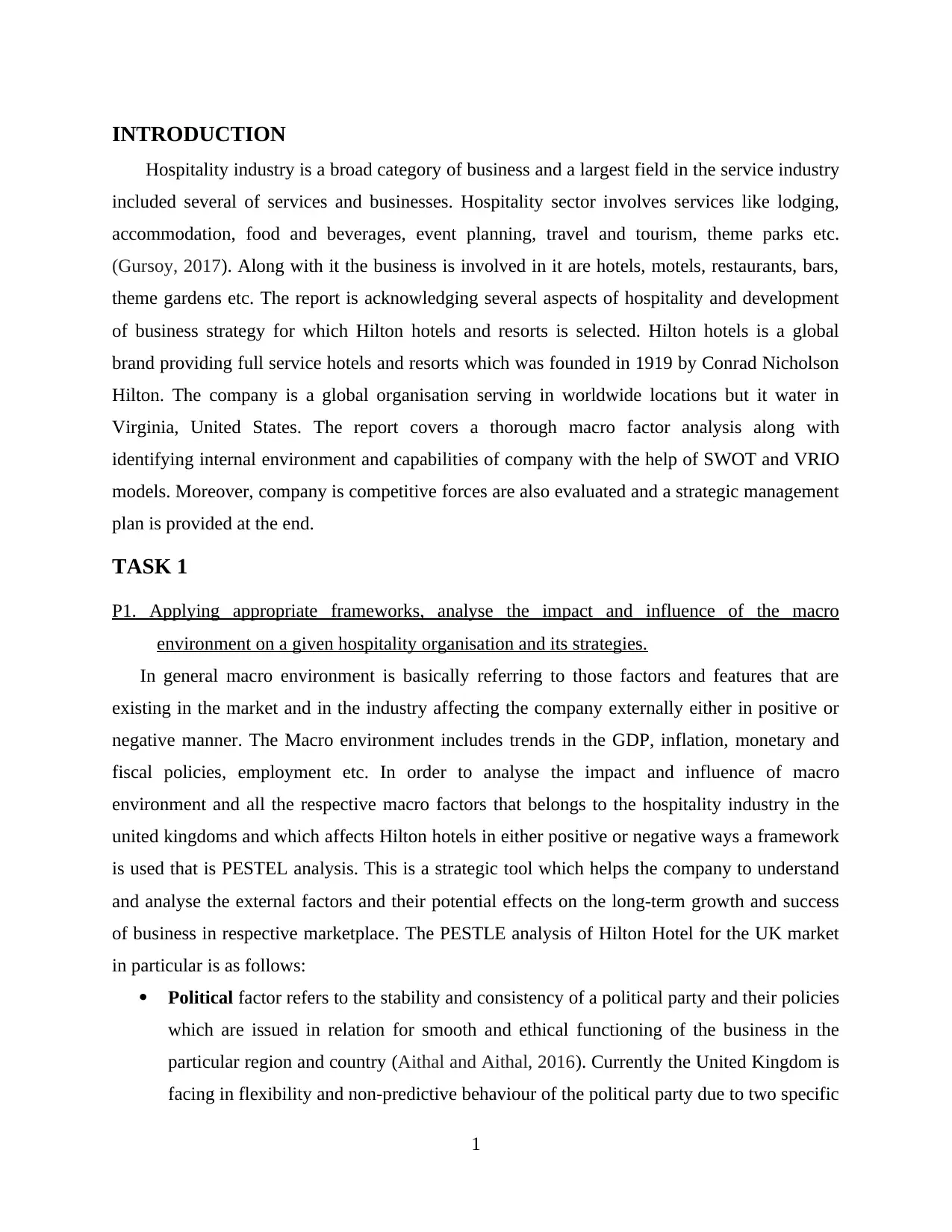
INTRODUCTION
Hospitality industry is a broad category of business and a largest field in the service industry
included several of services and businesses. Hospitality sector involves services like lodging,
accommodation, food and beverages, event planning, travel and tourism, theme parks etc.
(Gursoy, 2017). Along with it the business is involved in it are hotels, motels, restaurants, bars,
theme gardens etc. The report is acknowledging several aspects of hospitality and development
of business strategy for which Hilton hotels and resorts is selected. Hilton hotels is a global
brand providing full service hotels and resorts which was founded in 1919 by Conrad Nicholson
Hilton. The company is a global organisation serving in worldwide locations but it water in
Virginia, United States. The report covers a thorough macro factor analysis along with
identifying internal environment and capabilities of company with the help of SWOT and VRIO
models. Moreover, company is competitive forces are also evaluated and a strategic management
plan is provided at the end.
TASK 1
P1. Applying appropriate frameworks, analyse the impact and influence of the macro
environment on a given hospitality organisation and its strategies.
In general macro environment is basically referring to those factors and features that are
existing in the market and in the industry affecting the company externally either in positive or
negative manner. The Macro environment includes trends in the GDP, inflation, monetary and
fiscal policies, employment etc. In order to analyse the impact and influence of macro
environment and all the respective macro factors that belongs to the hospitality industry in the
united kingdoms and which affects Hilton hotels in either positive or negative ways a framework
is used that is PESTEL analysis. This is a strategic tool which helps the company to understand
and analyse the external factors and their potential effects on the long-term growth and success
of business in respective marketplace. The PESTLE analysis of Hilton Hotel for the UK market
in particular is as follows:
Political factor refers to the stability and consistency of a political party and their policies
which are issued in relation for smooth and ethical functioning of the business in the
particular region and country (Aithal and Aithal, 2016). Currently the United Kingdom is
facing in flexibility and non-predictive behaviour of the political party due to two specific
1
Hospitality industry is a broad category of business and a largest field in the service industry
included several of services and businesses. Hospitality sector involves services like lodging,
accommodation, food and beverages, event planning, travel and tourism, theme parks etc.
(Gursoy, 2017). Along with it the business is involved in it are hotels, motels, restaurants, bars,
theme gardens etc. The report is acknowledging several aspects of hospitality and development
of business strategy for which Hilton hotels and resorts is selected. Hilton hotels is a global
brand providing full service hotels and resorts which was founded in 1919 by Conrad Nicholson
Hilton. The company is a global organisation serving in worldwide locations but it water in
Virginia, United States. The report covers a thorough macro factor analysis along with
identifying internal environment and capabilities of company with the help of SWOT and VRIO
models. Moreover, company is competitive forces are also evaluated and a strategic management
plan is provided at the end.
TASK 1
P1. Applying appropriate frameworks, analyse the impact and influence of the macro
environment on a given hospitality organisation and its strategies.
In general macro environment is basically referring to those factors and features that are
existing in the market and in the industry affecting the company externally either in positive or
negative manner. The Macro environment includes trends in the GDP, inflation, monetary and
fiscal policies, employment etc. In order to analyse the impact and influence of macro
environment and all the respective macro factors that belongs to the hospitality industry in the
united kingdoms and which affects Hilton hotels in either positive or negative ways a framework
is used that is PESTEL analysis. This is a strategic tool which helps the company to understand
and analyse the external factors and their potential effects on the long-term growth and success
of business in respective marketplace. The PESTLE analysis of Hilton Hotel for the UK market
in particular is as follows:
Political factor refers to the stability and consistency of a political party and their policies
which are issued in relation for smooth and ethical functioning of the business in the
particular region and country (Aithal and Aithal, 2016). Currently the United Kingdom is
facing in flexibility and non-predictive behaviour of the political party due to two specific
1
⊘ This is a preview!⊘
Do you want full access?
Subscribe today to unlock all pages.

Trusted by 1+ million students worldwide

reasons that is recent initialisation of BREXIT and the outbreak of the deadliest disease
coronavirus. Both are the reasons behind an unstable political environment in the United
Kingdom which is negatively affecting not only the hospitality industry but all the
respective businesses and therefore political environment is not in favour of Hilton
Hotels.
Economic factors and economic downturn leads to declining in overseas travel and
tourism of individuals along with National visitors as well that directly affects and
influences the turnover and profitability of a hospitality business and the hospitality
industry an adverse manners. The economic environment of the United Kingdom is also
not stable because the country is in lockdown from few months from keeping people save
from coronavirus. This is negatively impacting the whole economy and most importantly
the hospitality industry and Hilton hotels because of its long term impacts on the industry
as well as on the organisation (Roma, Panniello and Nigro, 2019).
Social element of the Macro environment is refers and concerned with the population and
the social trends that are flourishing in the market and in the hospitality industry. The
United Kingdom is a market which incorporates a numerous International well known
and a highly influential brand which brings a advantage for Hilton Hotel as well because
of the strong and attractive goodwill and brand image of the organisation. Also the people
of UK are highly attracted towards luxury services and hospitality which also place a
positive path for the company. The negative impact of the social environment which is
going to affect Hilton hotel for the longer period is the after effects of coronavirus as now
people will ignore travelling from overseas or from National borders and which hinders
directly on the revenues and growth of company.
Technological element refers to the regular update and advancement taking place in the
technological and digital sector. This is a positive macro factor that it is actually in favour
of the company because through digital platforms and other technological devices it
becomes easy for Hilton hotel to be connected with the world and more specifically with
their existing customers (Okumus and et. al., 2017). The digitalization offers company an
opportunity to make use of social platforms to conduct marketing activities in very less
investment and also in very small time period. Along with it also influences the revenue
of the company because now hospitality industry is making use of online platforms and
2
coronavirus. Both are the reasons behind an unstable political environment in the United
Kingdom which is negatively affecting not only the hospitality industry but all the
respective businesses and therefore political environment is not in favour of Hilton
Hotels.
Economic factors and economic downturn leads to declining in overseas travel and
tourism of individuals along with National visitors as well that directly affects and
influences the turnover and profitability of a hospitality business and the hospitality
industry an adverse manners. The economic environment of the United Kingdom is also
not stable because the country is in lockdown from few months from keeping people save
from coronavirus. This is negatively impacting the whole economy and most importantly
the hospitality industry and Hilton hotels because of its long term impacts on the industry
as well as on the organisation (Roma, Panniello and Nigro, 2019).
Social element of the Macro environment is refers and concerned with the population and
the social trends that are flourishing in the market and in the hospitality industry. The
United Kingdom is a market which incorporates a numerous International well known
and a highly influential brand which brings a advantage for Hilton Hotel as well because
of the strong and attractive goodwill and brand image of the organisation. Also the people
of UK are highly attracted towards luxury services and hospitality which also place a
positive path for the company. The negative impact of the social environment which is
going to affect Hilton hotel for the longer period is the after effects of coronavirus as now
people will ignore travelling from overseas or from National borders and which hinders
directly on the revenues and growth of company.
Technological element refers to the regular update and advancement taking place in the
technological and digital sector. This is a positive macro factor that it is actually in favour
of the company because through digital platforms and other technological devices it
becomes easy for Hilton hotel to be connected with the world and more specifically with
their existing customers (Okumus and et. al., 2017). The digitalization offers company an
opportunity to make use of social platforms to conduct marketing activities in very less
investment and also in very small time period. Along with it also influences the revenue
of the company because now hospitality industry is making use of online platforms and
2
Paraphrase This Document
Need a fresh take? Get an instant paraphrase of this document with our AI Paraphraser
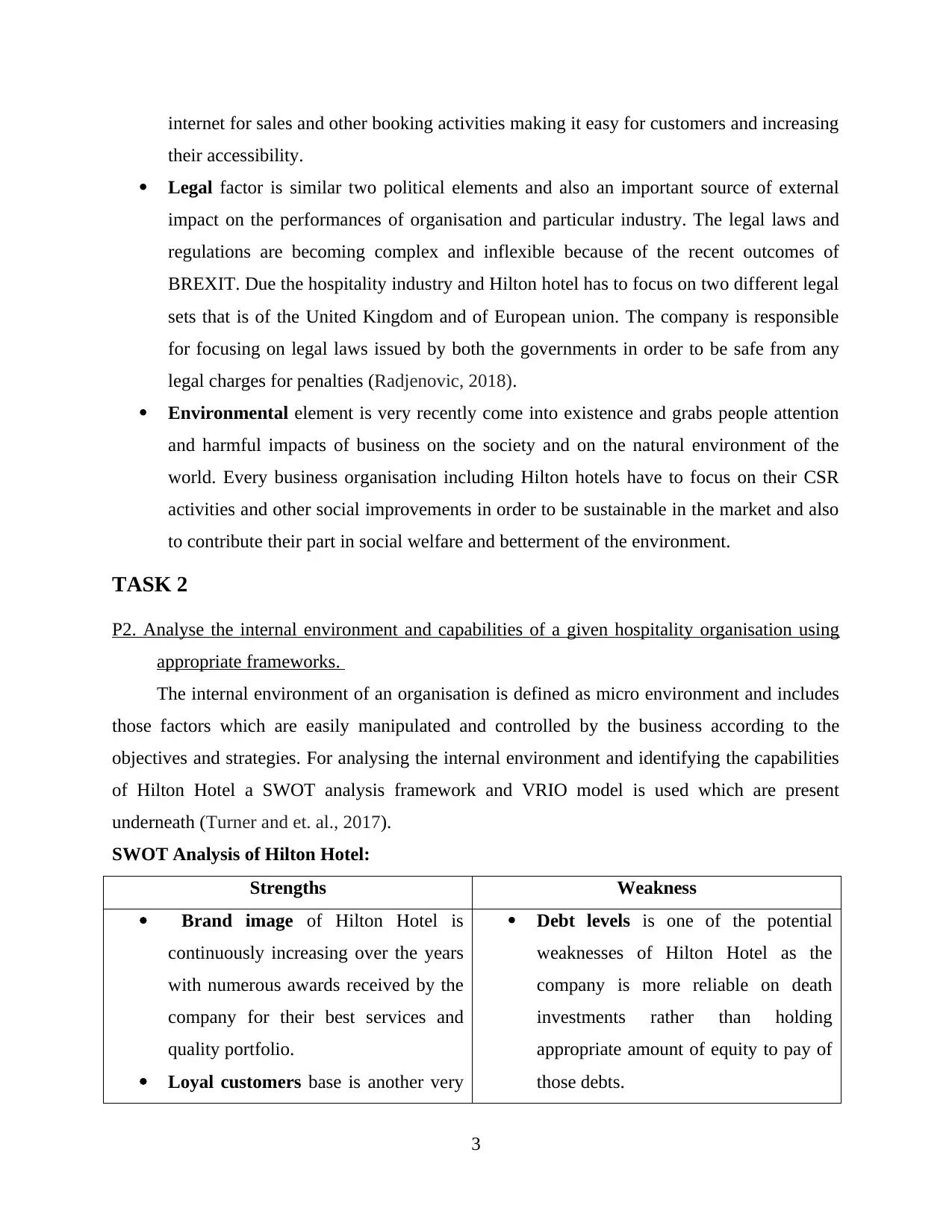
internet for sales and other booking activities making it easy for customers and increasing
their accessibility.
Legal factor is similar two political elements and also an important source of external
impact on the performances of organisation and particular industry. The legal laws and
regulations are becoming complex and inflexible because of the recent outcomes of
BREXIT. Due the hospitality industry and Hilton hotel has to focus on two different legal
sets that is of the United Kingdom and of European union. The company is responsible
for focusing on legal laws issued by both the governments in order to be safe from any
legal charges for penalties (Radjenovic, 2018).
Environmental element is very recently come into existence and grabs people attention
and harmful impacts of business on the society and on the natural environment of the
world. Every business organisation including Hilton hotels have to focus on their CSR
activities and other social improvements in order to be sustainable in the market and also
to contribute their part in social welfare and betterment of the environment.
TASK 2
P2. Analyse the internal environment and capabilities of a given hospitality organisation using
appropriate frameworks.
The internal environment of an organisation is defined as micro environment and includes
those factors which are easily manipulated and controlled by the business according to the
objectives and strategies. For analysing the internal environment and identifying the capabilities
of Hilton Hotel a SWOT analysis framework and VRIO model is used which are present
underneath (Turner and et. al., 2017).
SWOT Analysis of Hilton Hotel:
Strengths Weakness
Brand image of Hilton Hotel is
continuously increasing over the years
with numerous awards received by the
company for their best services and
quality portfolio.
Loyal customers base is another very
Debt levels is one of the potential
weaknesses of Hilton Hotel as the
company is more reliable on death
investments rather than holding
appropriate amount of equity to pay of
those debts.
3
their accessibility.
Legal factor is similar two political elements and also an important source of external
impact on the performances of organisation and particular industry. The legal laws and
regulations are becoming complex and inflexible because of the recent outcomes of
BREXIT. Due the hospitality industry and Hilton hotel has to focus on two different legal
sets that is of the United Kingdom and of European union. The company is responsible
for focusing on legal laws issued by both the governments in order to be safe from any
legal charges for penalties (Radjenovic, 2018).
Environmental element is very recently come into existence and grabs people attention
and harmful impacts of business on the society and on the natural environment of the
world. Every business organisation including Hilton hotels have to focus on their CSR
activities and other social improvements in order to be sustainable in the market and also
to contribute their part in social welfare and betterment of the environment.
TASK 2
P2. Analyse the internal environment and capabilities of a given hospitality organisation using
appropriate frameworks.
The internal environment of an organisation is defined as micro environment and includes
those factors which are easily manipulated and controlled by the business according to the
objectives and strategies. For analysing the internal environment and identifying the capabilities
of Hilton Hotel a SWOT analysis framework and VRIO model is used which are present
underneath (Turner and et. al., 2017).
SWOT Analysis of Hilton Hotel:
Strengths Weakness
Brand image of Hilton Hotel is
continuously increasing over the years
with numerous awards received by the
company for their best services and
quality portfolio.
Loyal customers base is another very
Debt levels is one of the potential
weaknesses of Hilton Hotel as the
company is more reliable on death
investments rather than holding
appropriate amount of equity to pay of
those debts.
3
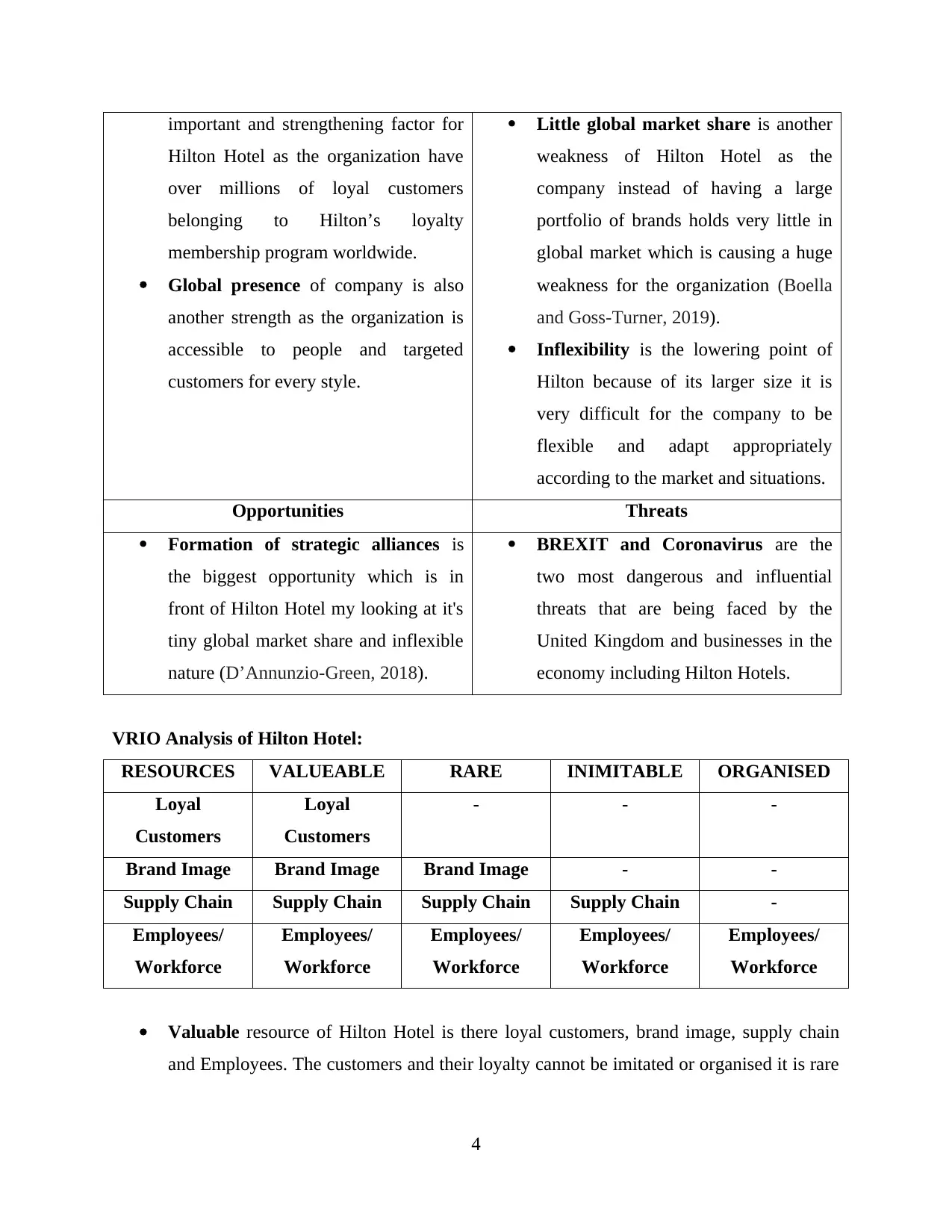
important and strengthening factor for
Hilton Hotel as the organization have
over millions of loyal customers
belonging to Hilton’s loyalty
membership program worldwide.
Global presence of company is also
another strength as the organization is
accessible to people and targeted
customers for every style.
Little global market share is another
weakness of Hilton Hotel as the
company instead of having a large
portfolio of brands holds very little in
global market which is causing a huge
weakness for the organization (Boella
and Goss-Turner, 2019).
Inflexibility is the lowering point of
Hilton because of its larger size it is
very difficult for the company to be
flexible and adapt appropriately
according to the market and situations.
Opportunities Threats
Formation of strategic alliances is
the biggest opportunity which is in
front of Hilton Hotel my looking at it's
tiny global market share and inflexible
nature (D’Annunzio-Green, 2018).
BREXIT and Coronavirus are the
two most dangerous and influential
threats that are being faced by the
United Kingdom and businesses in the
economy including Hilton Hotels.
VRIO Analysis of Hilton Hotel:
RESOURCES VALUEABLE RARE INIMITABLE ORGANISED
Loyal
Customers
Loyal
Customers
- - -
Brand Image Brand Image Brand Image - -
Supply Chain Supply Chain Supply Chain Supply Chain -
Employees/
Workforce
Employees/
Workforce
Employees/
Workforce
Employees/
Workforce
Employees/
Workforce
Valuable resource of Hilton Hotel is there loyal customers, brand image, supply chain
and Employees. The customers and their loyalty cannot be imitated or organised it is rare
4
Hilton Hotel as the organization have
over millions of loyal customers
belonging to Hilton’s loyalty
membership program worldwide.
Global presence of company is also
another strength as the organization is
accessible to people and targeted
customers for every style.
Little global market share is another
weakness of Hilton Hotel as the
company instead of having a large
portfolio of brands holds very little in
global market which is causing a huge
weakness for the organization (Boella
and Goss-Turner, 2019).
Inflexibility is the lowering point of
Hilton because of its larger size it is
very difficult for the company to be
flexible and adapt appropriately
according to the market and situations.
Opportunities Threats
Formation of strategic alliances is
the biggest opportunity which is in
front of Hilton Hotel my looking at it's
tiny global market share and inflexible
nature (D’Annunzio-Green, 2018).
BREXIT and Coronavirus are the
two most dangerous and influential
threats that are being faced by the
United Kingdom and businesses in the
economy including Hilton Hotels.
VRIO Analysis of Hilton Hotel:
RESOURCES VALUEABLE RARE INIMITABLE ORGANISED
Loyal
Customers
Loyal
Customers
- - -
Brand Image Brand Image Brand Image - -
Supply Chain Supply Chain Supply Chain Supply Chain -
Employees/
Workforce
Employees/
Workforce
Employees/
Workforce
Employees/
Workforce
Employees/
Workforce
Valuable resource of Hilton Hotel is there loyal customers, brand image, supply chain
and Employees. The customers and their loyalty cannot be imitated or organised it is rare
4
⊘ This is a preview!⊘
Do you want full access?
Subscribe today to unlock all pages.

Trusted by 1+ million students worldwide
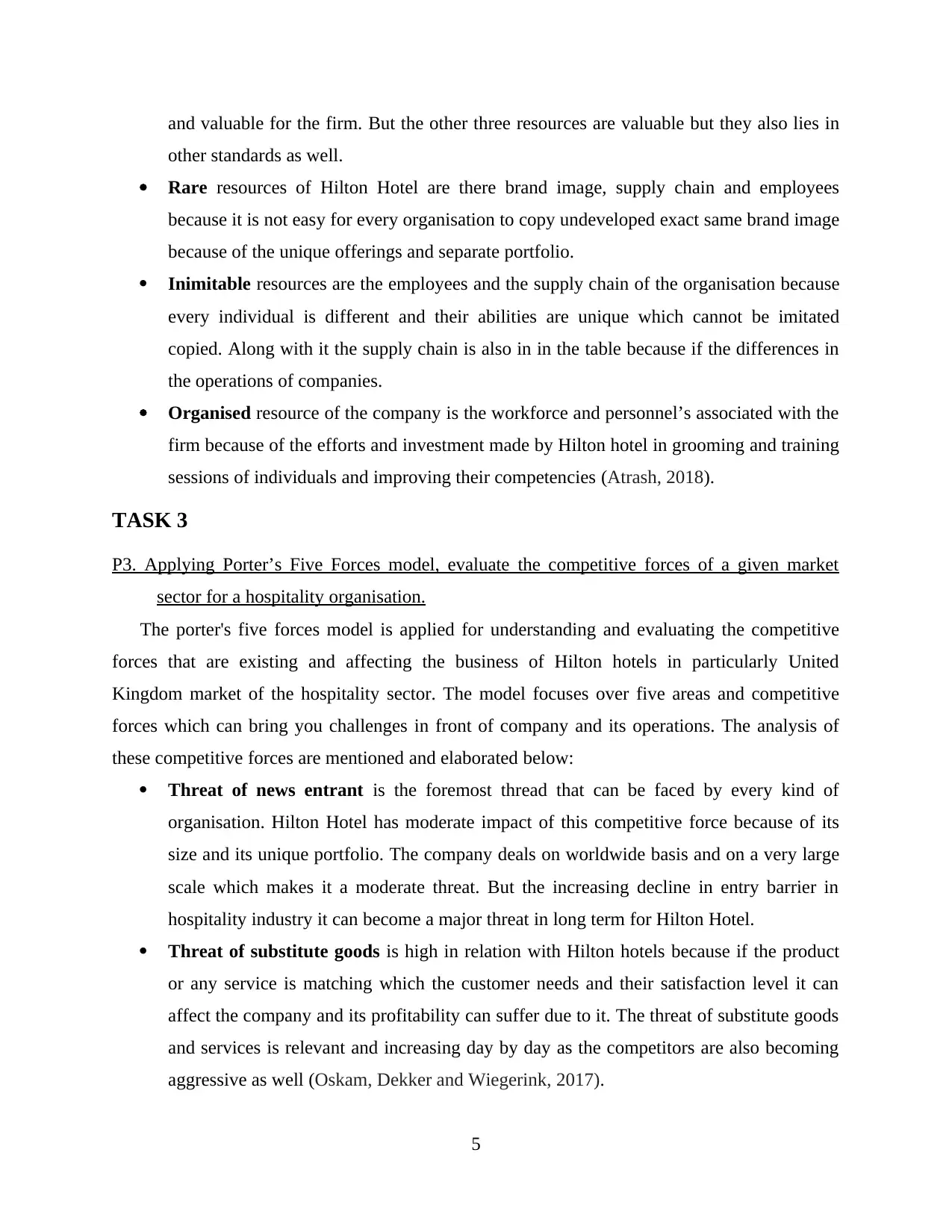
and valuable for the firm. But the other three resources are valuable but they also lies in
other standards as well.
Rare resources of Hilton Hotel are there brand image, supply chain and employees
because it is not easy for every organisation to copy undeveloped exact same brand image
because of the unique offerings and separate portfolio.
Inimitable resources are the employees and the supply chain of the organisation because
every individual is different and their abilities are unique which cannot be imitated
copied. Along with it the supply chain is also in in the table because if the differences in
the operations of companies.
Organised resource of the company is the workforce and personnel’s associated with the
firm because of the efforts and investment made by Hilton hotel in grooming and training
sessions of individuals and improving their competencies (Atrash, 2018).
TASK 3
P3. Applying Porter’s Five Forces model, evaluate the competitive forces of a given market
sector for a hospitality organisation.
The porter's five forces model is applied for understanding and evaluating the competitive
forces that are existing and affecting the business of Hilton hotels in particularly United
Kingdom market of the hospitality sector. The model focuses over five areas and competitive
forces which can bring you challenges in front of company and its operations. The analysis of
these competitive forces are mentioned and elaborated below:
Threat of news entrant is the foremost thread that can be faced by every kind of
organisation. Hilton Hotel has moderate impact of this competitive force because of its
size and its unique portfolio. The company deals on worldwide basis and on a very large
scale which makes it a moderate threat. But the increasing decline in entry barrier in
hospitality industry it can become a major threat in long term for Hilton Hotel.
Threat of substitute goods is high in relation with Hilton hotels because if the product
or any service is matching which the customer needs and their satisfaction level it can
affect the company and its profitability can suffer due to it. The threat of substitute goods
and services is relevant and increasing day by day as the competitors are also becoming
aggressive as well (Oskam, Dekker and Wiegerink, 2017).
5
other standards as well.
Rare resources of Hilton Hotel are there brand image, supply chain and employees
because it is not easy for every organisation to copy undeveloped exact same brand image
because of the unique offerings and separate portfolio.
Inimitable resources are the employees and the supply chain of the organisation because
every individual is different and their abilities are unique which cannot be imitated
copied. Along with it the supply chain is also in in the table because if the differences in
the operations of companies.
Organised resource of the company is the workforce and personnel’s associated with the
firm because of the efforts and investment made by Hilton hotel in grooming and training
sessions of individuals and improving their competencies (Atrash, 2018).
TASK 3
P3. Applying Porter’s Five Forces model, evaluate the competitive forces of a given market
sector for a hospitality organisation.
The porter's five forces model is applied for understanding and evaluating the competitive
forces that are existing and affecting the business of Hilton hotels in particularly United
Kingdom market of the hospitality sector. The model focuses over five areas and competitive
forces which can bring you challenges in front of company and its operations. The analysis of
these competitive forces are mentioned and elaborated below:
Threat of news entrant is the foremost thread that can be faced by every kind of
organisation. Hilton Hotel has moderate impact of this competitive force because of its
size and its unique portfolio. The company deals on worldwide basis and on a very large
scale which makes it a moderate threat. But the increasing decline in entry barrier in
hospitality industry it can become a major threat in long term for Hilton Hotel.
Threat of substitute goods is high in relation with Hilton hotels because if the product
or any service is matching which the customer needs and their satisfaction level it can
affect the company and its profitability can suffer due to it. The threat of substitute goods
and services is relevant and increasing day by day as the competitors are also becoming
aggressive as well (Oskam, Dekker and Wiegerink, 2017).
5
Paraphrase This Document
Need a fresh take? Get an instant paraphrase of this document with our AI Paraphraser
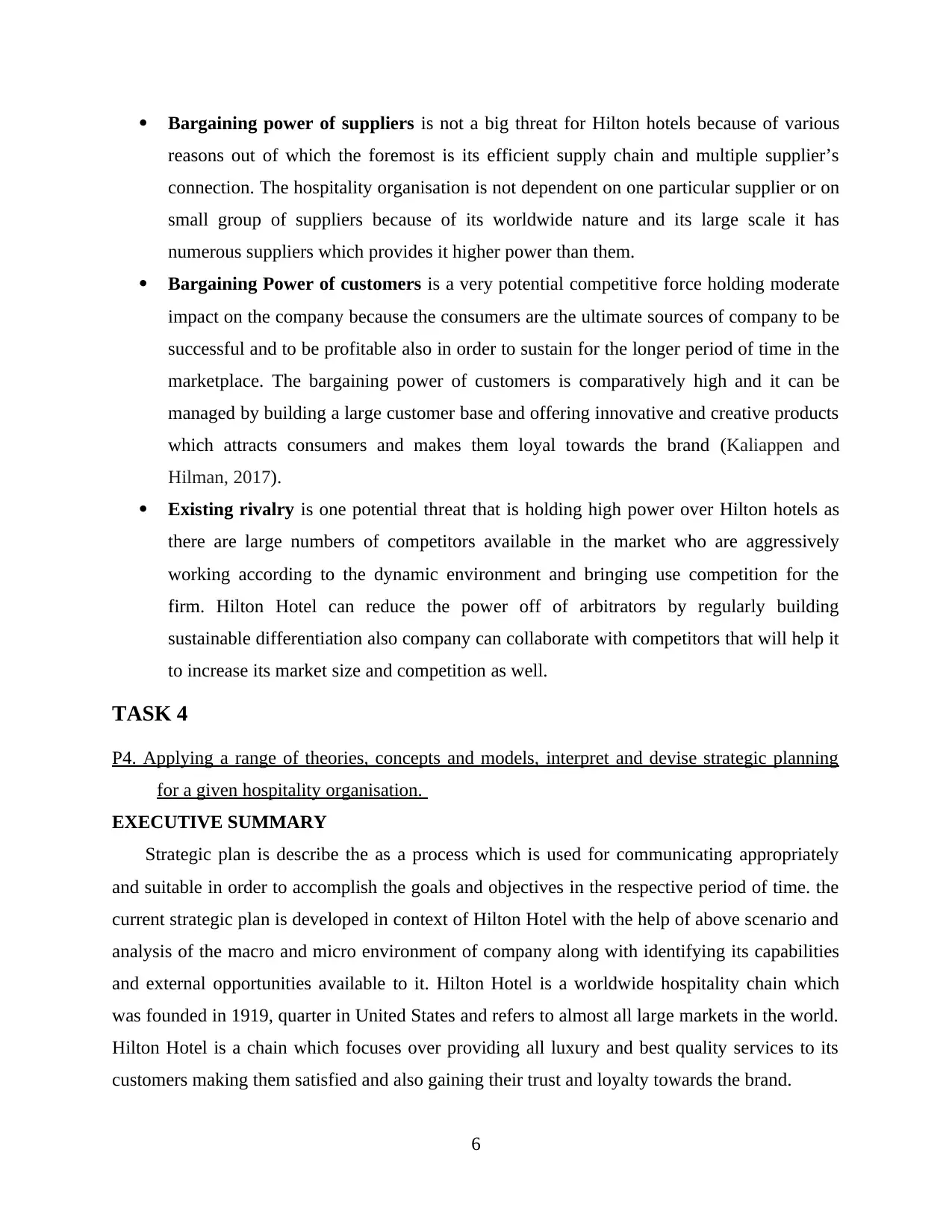
Bargaining power of suppliers is not a big threat for Hilton hotels because of various
reasons out of which the foremost is its efficient supply chain and multiple supplier’s
connection. The hospitality organisation is not dependent on one particular supplier or on
small group of suppliers because of its worldwide nature and its large scale it has
numerous suppliers which provides it higher power than them.
Bargaining Power of customers is a very potential competitive force holding moderate
impact on the company because the consumers are the ultimate sources of company to be
successful and to be profitable also in order to sustain for the longer period of time in the
marketplace. The bargaining power of customers is comparatively high and it can be
managed by building a large customer base and offering innovative and creative products
which attracts consumers and makes them loyal towards the brand (Kaliappen and
Hilman, 2017).
Existing rivalry is one potential threat that is holding high power over Hilton hotels as
there are large numbers of competitors available in the market who are aggressively
working according to the dynamic environment and bringing use competition for the
firm. Hilton Hotel can reduce the power off of arbitrators by regularly building
sustainable differentiation also company can collaborate with competitors that will help it
to increase its market size and competition as well.
TASK 4
P4. Applying a range of theories, concepts and models, interpret and devise strategic planning
for a given hospitality organisation.
EXECUTIVE SUMMARY
Strategic plan is describe the as a process which is used for communicating appropriately
and suitable in order to accomplish the goals and objectives in the respective period of time. the
current strategic plan is developed in context of Hilton Hotel with the help of above scenario and
analysis of the macro and micro environment of company along with identifying its capabilities
and external opportunities available to it. Hilton Hotel is a worldwide hospitality chain which
was founded in 1919, quarter in United States and refers to almost all large markets in the world.
Hilton Hotel is a chain which focuses over providing all luxury and best quality services to its
customers making them satisfied and also gaining their trust and loyalty towards the brand.
6
reasons out of which the foremost is its efficient supply chain and multiple supplier’s
connection. The hospitality organisation is not dependent on one particular supplier or on
small group of suppliers because of its worldwide nature and its large scale it has
numerous suppliers which provides it higher power than them.
Bargaining Power of customers is a very potential competitive force holding moderate
impact on the company because the consumers are the ultimate sources of company to be
successful and to be profitable also in order to sustain for the longer period of time in the
marketplace. The bargaining power of customers is comparatively high and it can be
managed by building a large customer base and offering innovative and creative products
which attracts consumers and makes them loyal towards the brand (Kaliappen and
Hilman, 2017).
Existing rivalry is one potential threat that is holding high power over Hilton hotels as
there are large numbers of competitors available in the market who are aggressively
working according to the dynamic environment and bringing use competition for the
firm. Hilton Hotel can reduce the power off of arbitrators by regularly building
sustainable differentiation also company can collaborate with competitors that will help it
to increase its market size and competition as well.
TASK 4
P4. Applying a range of theories, concepts and models, interpret and devise strategic planning
for a given hospitality organisation.
EXECUTIVE SUMMARY
Strategic plan is describe the as a process which is used for communicating appropriately
and suitable in order to accomplish the goals and objectives in the respective period of time. the
current strategic plan is developed in context of Hilton Hotel with the help of above scenario and
analysis of the macro and micro environment of company along with identifying its capabilities
and external opportunities available to it. Hilton Hotel is a worldwide hospitality chain which
was founded in 1919, quarter in United States and refers to almost all large markets in the world.
Hilton Hotel is a chain which focuses over providing all luxury and best quality services to its
customers making them satisfied and also gaining their trust and loyalty towards the brand.
6
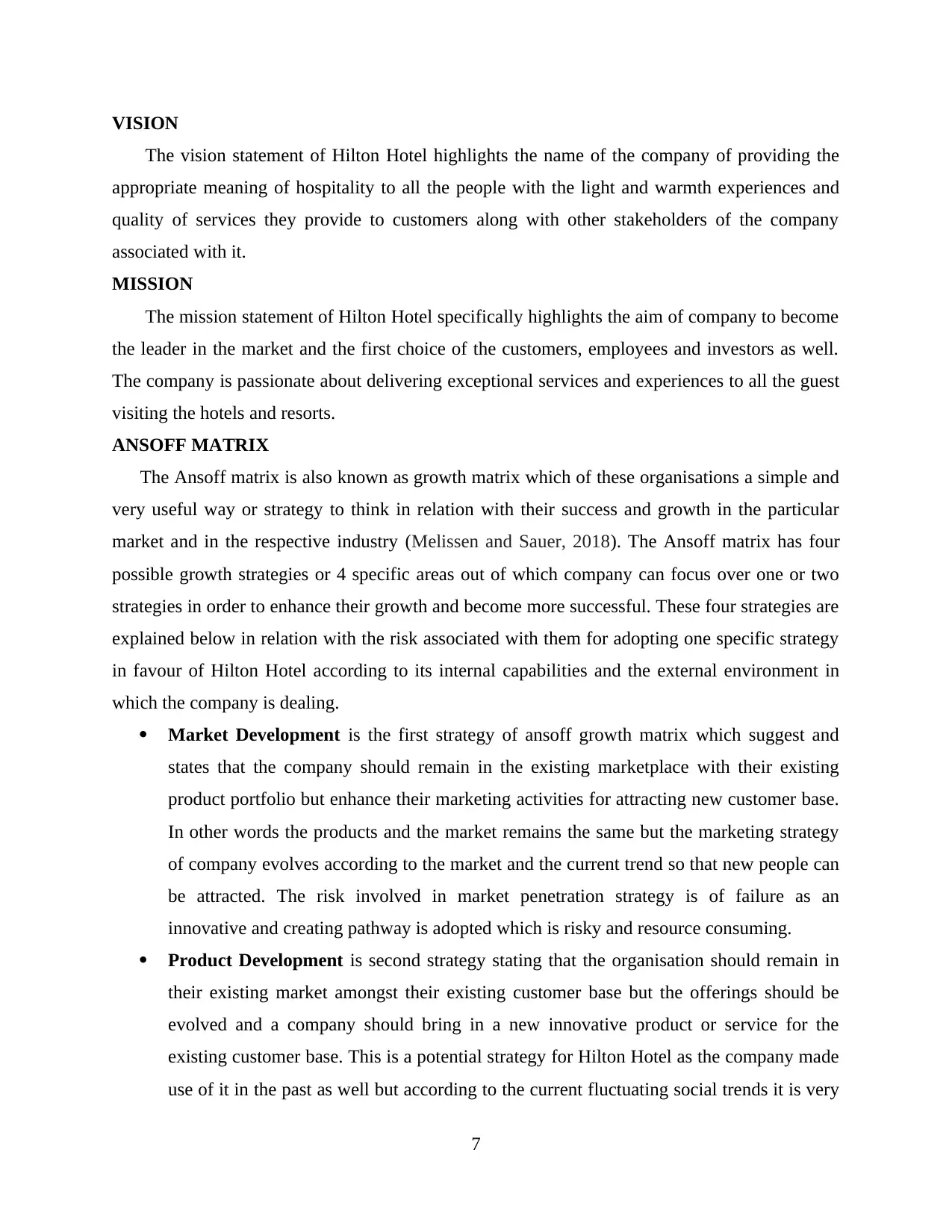
VISION
The vision statement of Hilton Hotel highlights the name of the company of providing the
appropriate meaning of hospitality to all the people with the light and warmth experiences and
quality of services they provide to customers along with other stakeholders of the company
associated with it.
MISSION
The mission statement of Hilton Hotel specifically highlights the aim of company to become
the leader in the market and the first choice of the customers, employees and investors as well.
The company is passionate about delivering exceptional services and experiences to all the guest
visiting the hotels and resorts.
ANSOFF MATRIX
The Ansoff matrix is also known as growth matrix which of these organisations a simple and
very useful way or strategy to think in relation with their success and growth in the particular
market and in the respective industry (Melissen and Sauer, 2018). The Ansoff matrix has four
possible growth strategies or 4 specific areas out of which company can focus over one or two
strategies in order to enhance their growth and become more successful. These four strategies are
explained below in relation with the risk associated with them for adopting one specific strategy
in favour of Hilton Hotel according to its internal capabilities and the external environment in
which the company is dealing.
Market Development is the first strategy of ansoff growth matrix which suggest and
states that the company should remain in the existing marketplace with their existing
product portfolio but enhance their marketing activities for attracting new customer base.
In other words the products and the market remains the same but the marketing strategy
of company evolves according to the market and the current trend so that new people can
be attracted. The risk involved in market penetration strategy is of failure as an
innovative and creating pathway is adopted which is risky and resource consuming.
Product Development is second strategy stating that the organisation should remain in
their existing market amongst their existing customer base but the offerings should be
evolved and a company should bring in a new innovative product or service for the
existing customer base. This is a potential strategy for Hilton Hotel as the company made
use of it in the past as well but according to the current fluctuating social trends it is very
7
The vision statement of Hilton Hotel highlights the name of the company of providing the
appropriate meaning of hospitality to all the people with the light and warmth experiences and
quality of services they provide to customers along with other stakeholders of the company
associated with it.
MISSION
The mission statement of Hilton Hotel specifically highlights the aim of company to become
the leader in the market and the first choice of the customers, employees and investors as well.
The company is passionate about delivering exceptional services and experiences to all the guest
visiting the hotels and resorts.
ANSOFF MATRIX
The Ansoff matrix is also known as growth matrix which of these organisations a simple and
very useful way or strategy to think in relation with their success and growth in the particular
market and in the respective industry (Melissen and Sauer, 2018). The Ansoff matrix has four
possible growth strategies or 4 specific areas out of which company can focus over one or two
strategies in order to enhance their growth and become more successful. These four strategies are
explained below in relation with the risk associated with them for adopting one specific strategy
in favour of Hilton Hotel according to its internal capabilities and the external environment in
which the company is dealing.
Market Development is the first strategy of ansoff growth matrix which suggest and
states that the company should remain in the existing marketplace with their existing
product portfolio but enhance their marketing activities for attracting new customer base.
In other words the products and the market remains the same but the marketing strategy
of company evolves according to the market and the current trend so that new people can
be attracted. The risk involved in market penetration strategy is of failure as an
innovative and creating pathway is adopted which is risky and resource consuming.
Product Development is second strategy stating that the organisation should remain in
their existing market amongst their existing customer base but the offerings should be
evolved and a company should bring in a new innovative product or service for the
existing customer base. This is a potential strategy for Hilton Hotel as the company made
use of it in the past as well but according to the current fluctuating social trends it is very
7
⊘ This is a preview!⊘
Do you want full access?
Subscribe today to unlock all pages.

Trusted by 1+ million students worldwide
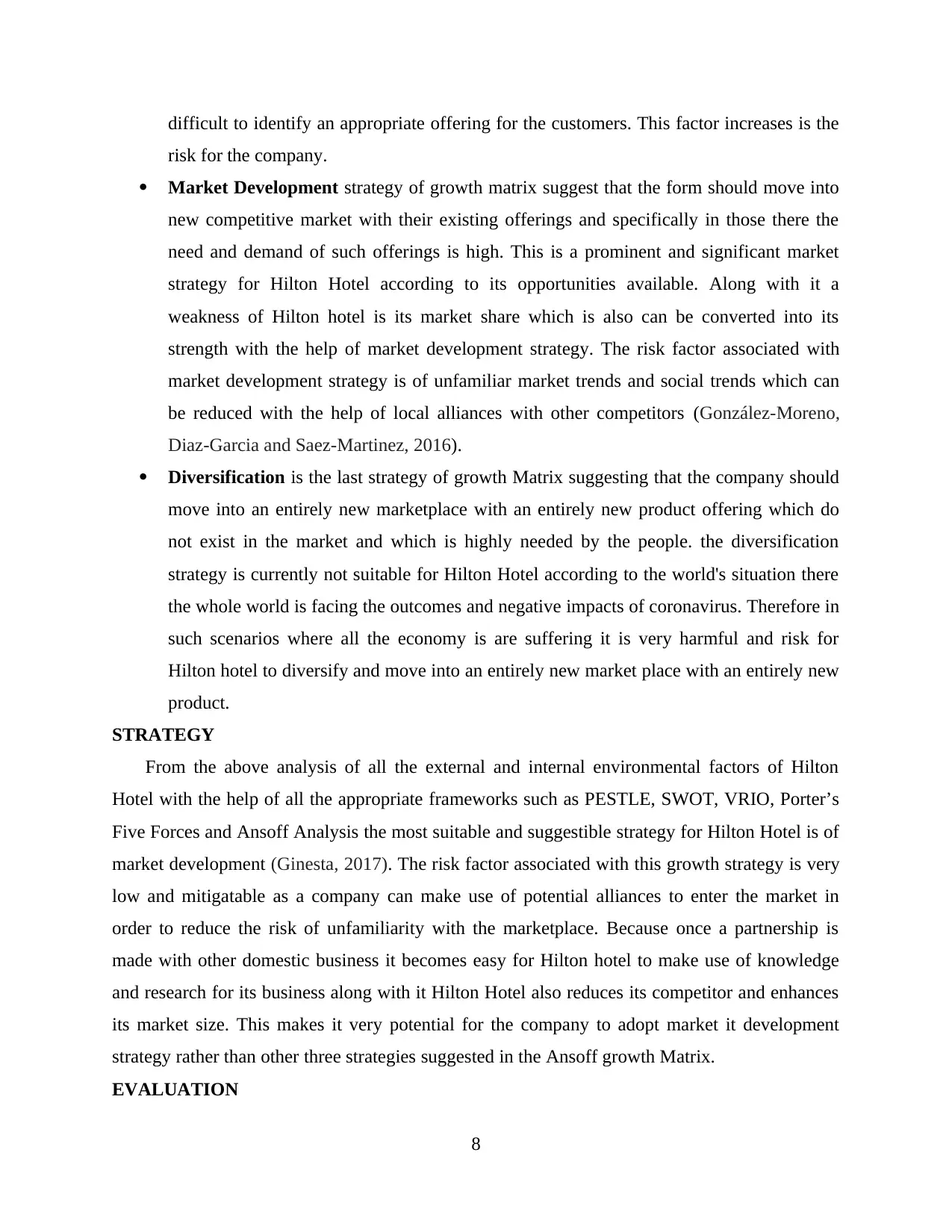
difficult to identify an appropriate offering for the customers. This factor increases is the
risk for the company.
Market Development strategy of growth matrix suggest that the form should move into
new competitive market with their existing offerings and specifically in those there the
need and demand of such offerings is high. This is a prominent and significant market
strategy for Hilton Hotel according to its opportunities available. Along with it a
weakness of Hilton hotel is its market share which is also can be converted into its
strength with the help of market development strategy. The risk factor associated with
market development strategy is of unfamiliar market trends and social trends which can
be reduced with the help of local alliances with other competitors (González-Moreno,
Diaz-Garcia and Saez-Martinez, 2016).
Diversification is the last strategy of growth Matrix suggesting that the company should
move into an entirely new marketplace with an entirely new product offering which do
not exist in the market and which is highly needed by the people. the diversification
strategy is currently not suitable for Hilton Hotel according to the world's situation there
the whole world is facing the outcomes and negative impacts of coronavirus. Therefore in
such scenarios where all the economy is are suffering it is very harmful and risk for
Hilton hotel to diversify and move into an entirely new market place with an entirely new
product.
STRATEGY
From the above analysis of all the external and internal environmental factors of Hilton
Hotel with the help of all the appropriate frameworks such as PESTLE, SWOT, VRIO, Porter’s
Five Forces and Ansoff Analysis the most suitable and suggestible strategy for Hilton Hotel is of
market development (Ginesta, 2017). The risk factor associated with this growth strategy is very
low and mitigatable as a company can make use of potential alliances to enter the market in
order to reduce the risk of unfamiliarity with the marketplace. Because once a partnership is
made with other domestic business it becomes easy for Hilton hotel to make use of knowledge
and research for its business along with it Hilton Hotel also reduces its competitor and enhances
its market size. This makes it very potential for the company to adopt market it development
strategy rather than other three strategies suggested in the Ansoff growth Matrix.
EVALUATION
8
risk for the company.
Market Development strategy of growth matrix suggest that the form should move into
new competitive market with their existing offerings and specifically in those there the
need and demand of such offerings is high. This is a prominent and significant market
strategy for Hilton Hotel according to its opportunities available. Along with it a
weakness of Hilton hotel is its market share which is also can be converted into its
strength with the help of market development strategy. The risk factor associated with
market development strategy is of unfamiliar market trends and social trends which can
be reduced with the help of local alliances with other competitors (González-Moreno,
Diaz-Garcia and Saez-Martinez, 2016).
Diversification is the last strategy of growth Matrix suggesting that the company should
move into an entirely new marketplace with an entirely new product offering which do
not exist in the market and which is highly needed by the people. the diversification
strategy is currently not suitable for Hilton Hotel according to the world's situation there
the whole world is facing the outcomes and negative impacts of coronavirus. Therefore in
such scenarios where all the economy is are suffering it is very harmful and risk for
Hilton hotel to diversify and move into an entirely new market place with an entirely new
product.
STRATEGY
From the above analysis of all the external and internal environmental factors of Hilton
Hotel with the help of all the appropriate frameworks such as PESTLE, SWOT, VRIO, Porter’s
Five Forces and Ansoff Analysis the most suitable and suggestible strategy for Hilton Hotel is of
market development (Ginesta, 2017). The risk factor associated with this growth strategy is very
low and mitigatable as a company can make use of potential alliances to enter the market in
order to reduce the risk of unfamiliarity with the marketplace. Because once a partnership is
made with other domestic business it becomes easy for Hilton hotel to make use of knowledge
and research for its business along with it Hilton Hotel also reduces its competitor and enhances
its market size. This makes it very potential for the company to adopt market it development
strategy rather than other three strategies suggested in the Ansoff growth Matrix.
EVALUATION
8
Paraphrase This Document
Need a fresh take? Get an instant paraphrase of this document with our AI Paraphraser
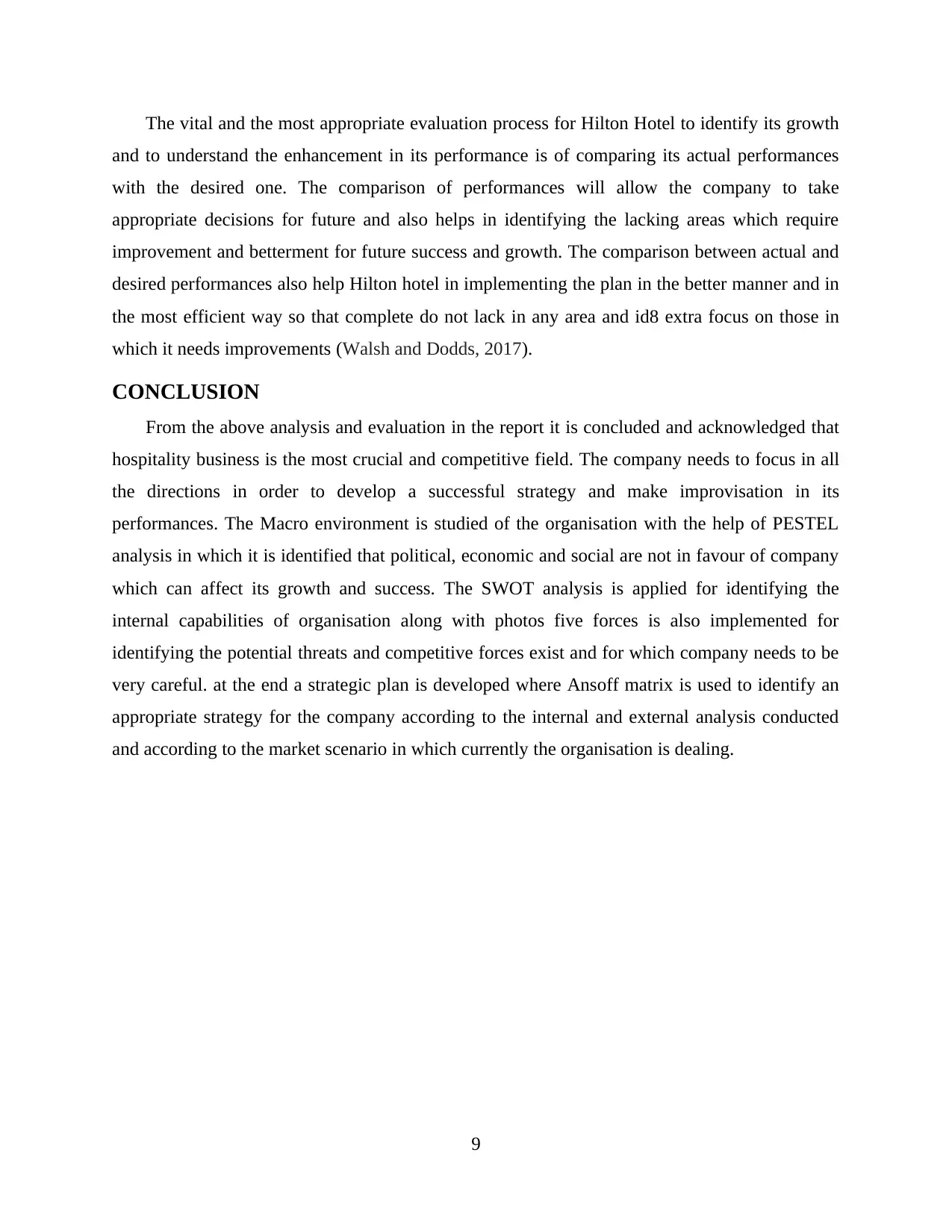
The vital and the most appropriate evaluation process for Hilton Hotel to identify its growth
and to understand the enhancement in its performance is of comparing its actual performances
with the desired one. The comparison of performances will allow the company to take
appropriate decisions for future and also helps in identifying the lacking areas which require
improvement and betterment for future success and growth. The comparison between actual and
desired performances also help Hilton hotel in implementing the plan in the better manner and in
the most efficient way so that complete do not lack in any area and id8 extra focus on those in
which it needs improvements (Walsh and Dodds, 2017).
CONCLUSION
From the above analysis and evaluation in the report it is concluded and acknowledged that
hospitality business is the most crucial and competitive field. The company needs to focus in all
the directions in order to develop a successful strategy and make improvisation in its
performances. The Macro environment is studied of the organisation with the help of PESTEL
analysis in which it is identified that political, economic and social are not in favour of company
which can affect its growth and success. The SWOT analysis is applied for identifying the
internal capabilities of organisation along with photos five forces is also implemented for
identifying the potential threats and competitive forces exist and for which company needs to be
very careful. at the end a strategic plan is developed where Ansoff matrix is used to identify an
appropriate strategy for the company according to the internal and external analysis conducted
and according to the market scenario in which currently the organisation is dealing.
9
and to understand the enhancement in its performance is of comparing its actual performances
with the desired one. The comparison of performances will allow the company to take
appropriate decisions for future and also helps in identifying the lacking areas which require
improvement and betterment for future success and growth. The comparison between actual and
desired performances also help Hilton hotel in implementing the plan in the better manner and in
the most efficient way so that complete do not lack in any area and id8 extra focus on those in
which it needs improvements (Walsh and Dodds, 2017).
CONCLUSION
From the above analysis and evaluation in the report it is concluded and acknowledged that
hospitality business is the most crucial and competitive field. The company needs to focus in all
the directions in order to develop a successful strategy and make improvisation in its
performances. The Macro environment is studied of the organisation with the help of PESTEL
analysis in which it is identified that political, economic and social are not in favour of company
which can affect its growth and success. The SWOT analysis is applied for identifying the
internal capabilities of organisation along with photos five forces is also implemented for
identifying the potential threats and competitive forces exist and for which company needs to be
very careful. at the end a strategic plan is developed where Ansoff matrix is used to identify an
appropriate strategy for the company according to the internal and external analysis conducted
and according to the market scenario in which currently the organisation is dealing.
9
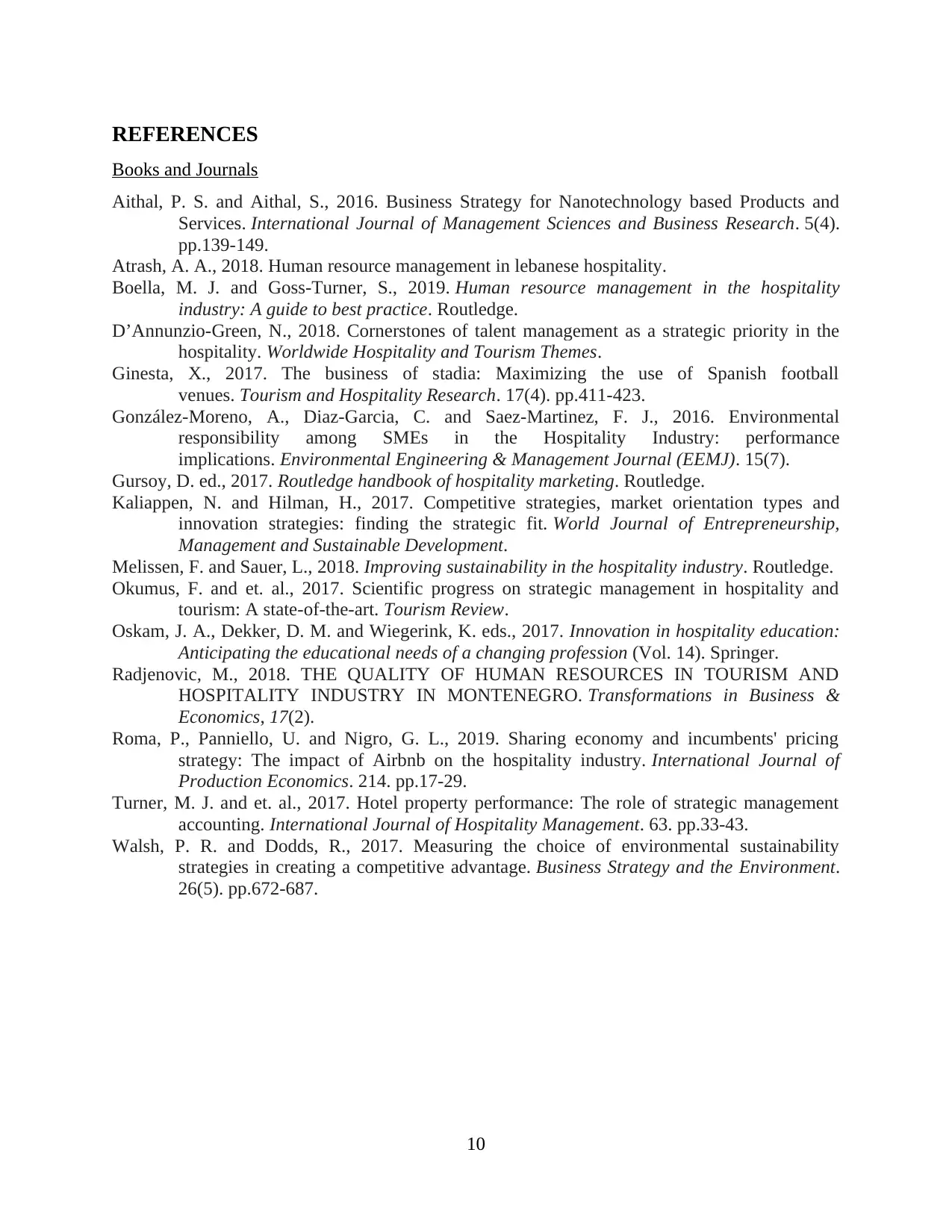
REFERENCES
Books and Journals
Aithal, P. S. and Aithal, S., 2016. Business Strategy for Nanotechnology based Products and
Services. International Journal of Management Sciences and Business Research. 5(4).
pp.139-149.
Atrash, A. A., 2018. Human resource management in lebanese hospitality.
Boella, M. J. and Goss-Turner, S., 2019. Human resource management in the hospitality
industry: A guide to best practice. Routledge.
D’Annunzio-Green, N., 2018. Cornerstones of talent management as a strategic priority in the
hospitality. Worldwide Hospitality and Tourism Themes.
Ginesta, X., 2017. The business of stadia: Maximizing the use of Spanish football
venues. Tourism and Hospitality Research. 17(4). pp.411-423.
González-Moreno, A., Diaz-Garcia, C. and Saez-Martinez, F. J., 2016. Environmental
responsibility among SMEs in the Hospitality Industry: performance
implications. Environmental Engineering & Management Journal (EEMJ). 15(7).
Gursoy, D. ed., 2017. Routledge handbook of hospitality marketing. Routledge.
Kaliappen, N. and Hilman, H., 2017. Competitive strategies, market orientation types and
innovation strategies: finding the strategic fit. World Journal of Entrepreneurship,
Management and Sustainable Development.
Melissen, F. and Sauer, L., 2018. Improving sustainability in the hospitality industry. Routledge.
Okumus, F. and et. al., 2017. Scientific progress on strategic management in hospitality and
tourism: A state-of-the-art. Tourism Review.
Oskam, J. A., Dekker, D. M. and Wiegerink, K. eds., 2017. Innovation in hospitality education:
Anticipating the educational needs of a changing profession (Vol. 14). Springer.
Radjenovic, M., 2018. THE QUALITY OF HUMAN RESOURCES IN TOURISM AND
HOSPITALITY INDUSTRY IN MONTENEGRO. Transformations in Business &
Economics, 17(2).
Roma, P., Panniello, U. and Nigro, G. L., 2019. Sharing economy and incumbents' pricing
strategy: The impact of Airbnb on the hospitality industry. International Journal of
Production Economics. 214. pp.17-29.
Turner, M. J. and et. al., 2017. Hotel property performance: The role of strategic management
accounting. International Journal of Hospitality Management. 63. pp.33-43.
Walsh, P. R. and Dodds, R., 2017. Measuring the choice of environmental sustainability
strategies in creating a competitive advantage. Business Strategy and the Environment.
26(5). pp.672-687.
10
Books and Journals
Aithal, P. S. and Aithal, S., 2016. Business Strategy for Nanotechnology based Products and
Services. International Journal of Management Sciences and Business Research. 5(4).
pp.139-149.
Atrash, A. A., 2018. Human resource management in lebanese hospitality.
Boella, M. J. and Goss-Turner, S., 2019. Human resource management in the hospitality
industry: A guide to best practice. Routledge.
D’Annunzio-Green, N., 2018. Cornerstones of talent management as a strategic priority in the
hospitality. Worldwide Hospitality and Tourism Themes.
Ginesta, X., 2017. The business of stadia: Maximizing the use of Spanish football
venues. Tourism and Hospitality Research. 17(4). pp.411-423.
González-Moreno, A., Diaz-Garcia, C. and Saez-Martinez, F. J., 2016. Environmental
responsibility among SMEs in the Hospitality Industry: performance
implications. Environmental Engineering & Management Journal (EEMJ). 15(7).
Gursoy, D. ed., 2017. Routledge handbook of hospitality marketing. Routledge.
Kaliappen, N. and Hilman, H., 2017. Competitive strategies, market orientation types and
innovation strategies: finding the strategic fit. World Journal of Entrepreneurship,
Management and Sustainable Development.
Melissen, F. and Sauer, L., 2018. Improving sustainability in the hospitality industry. Routledge.
Okumus, F. and et. al., 2017. Scientific progress on strategic management in hospitality and
tourism: A state-of-the-art. Tourism Review.
Oskam, J. A., Dekker, D. M. and Wiegerink, K. eds., 2017. Innovation in hospitality education:
Anticipating the educational needs of a changing profession (Vol. 14). Springer.
Radjenovic, M., 2018. THE QUALITY OF HUMAN RESOURCES IN TOURISM AND
HOSPITALITY INDUSTRY IN MONTENEGRO. Transformations in Business &
Economics, 17(2).
Roma, P., Panniello, U. and Nigro, G. L., 2019. Sharing economy and incumbents' pricing
strategy: The impact of Airbnb on the hospitality industry. International Journal of
Production Economics. 214. pp.17-29.
Turner, M. J. and et. al., 2017. Hotel property performance: The role of strategic management
accounting. International Journal of Hospitality Management. 63. pp.33-43.
Walsh, P. R. and Dodds, R., 2017. Measuring the choice of environmental sustainability
strategies in creating a competitive advantage. Business Strategy and the Environment.
26(5). pp.672-687.
10
⊘ This is a preview!⊘
Do you want full access?
Subscribe today to unlock all pages.

Trusted by 1+ million students worldwide
1 out of 12
Related Documents
Your All-in-One AI-Powered Toolkit for Academic Success.
+13062052269
info@desklib.com
Available 24*7 on WhatsApp / Email
![[object Object]](/_next/static/media/star-bottom.7253800d.svg)
Unlock your academic potential
Copyright © 2020–2025 A2Z Services. All Rights Reserved. Developed and managed by ZUCOL.



